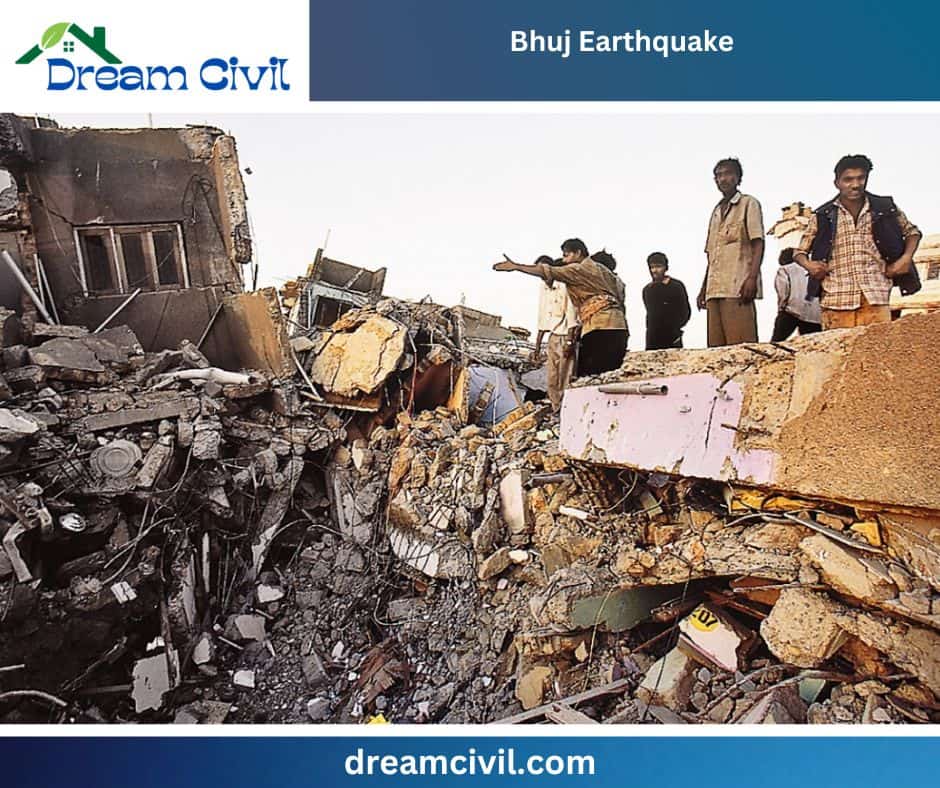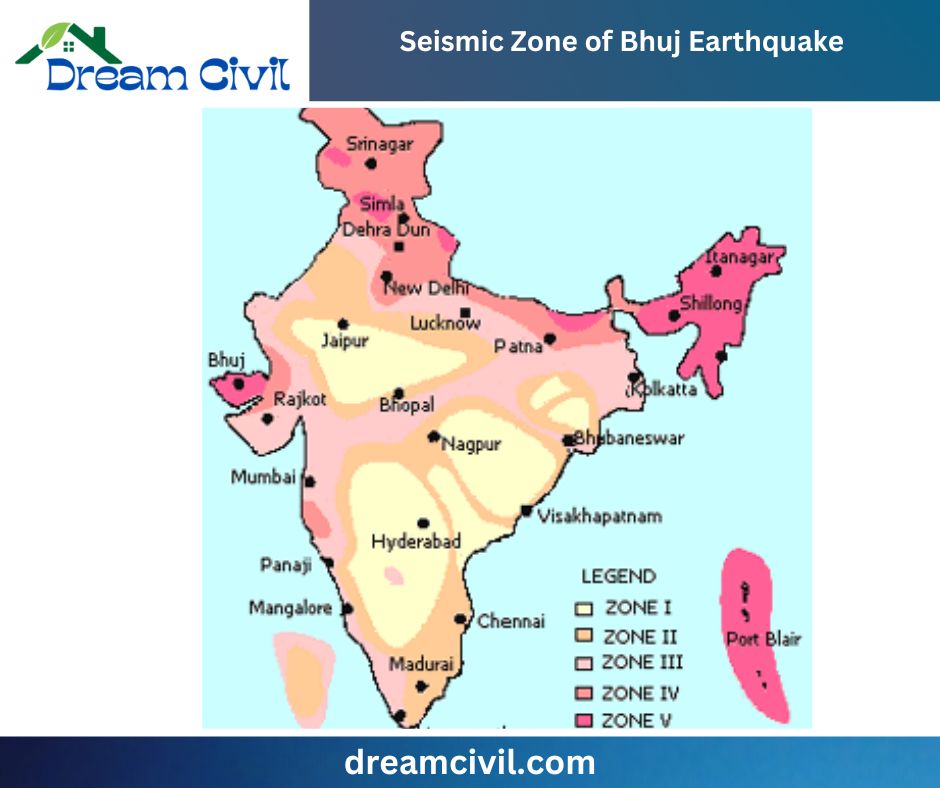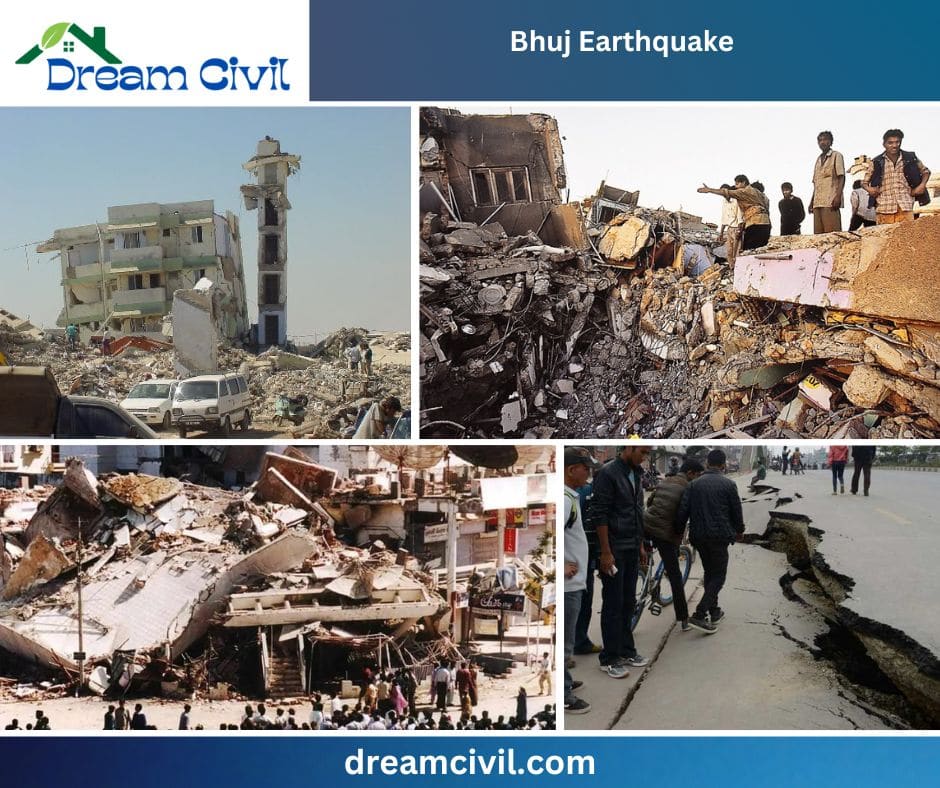Table of Contents
✔ This article will discuss the Bhuj Earthquake, also known as the 2001 Gujarat Earthquake.
1. Introduction
Earthquake, A Natural Disaster !!

✔ Humans are the superior social animals instilled with emotions, feelings, and, most importantly, wisdom. The world has dramatically evolved from the primitive Stone Age to the modern world. The credit for this drastic change solely goes to humans and their broad horizons of knowledge.
✔ With the advancement of technology, it seems that there is nothing humans cannot achieve. Despite all the development and improvement, one aspect of nature still exists beyond humans’ control, i.e., natural disasters.
✔ Natural disasters are unpredictable events of nature, primarily resulting in catastrophic damage. An earthquake is a natural disaster that humans still do not have any hold of.
✔ An earthquake is a sudden movement of the Earth’s surface or ground resulting from the passage of seismic waves.
✔ It is unpredictable and can occur any day of the year, any second time, causing a lot of negative impacts and suffering.
✔ The world has witnessed many devastating quakes that caused significant destruction and losses, and one such earthquake is the Bhuj Earthquake.
2. Bhuj Earthquake: The Event
✔ On January 26, 2001, India was all set to celebrate the 52nd Republic Day, so a massive earthquake struck Gujarat.

✔ The Bhuj Earthquake, also known as the 2001 Gujarat Earthquake, occurred at 8:46 a.m.
✔ The epicenter was at Bhuj, which is the District headquarters of Kutch district in the state of Gujarat.
✔ The earthquake was mighty and recorded 6.9 Mb on the Richter scale (Mw 7.6).
✔ It lasted over two minutes, and what happened next was unimaginable and catastrophic.
✔ The shakes induced were felt in about 70% of the country’s regions, and the tremors were felt even in Nepal and Pakistan.
✔ It resulted in a loss of over 20,000 lives and left behind around 1.7 lakh people injured.
✔ Moreover, it caused severe damage to the physical infrastructure and left over 229 villages damaged beyond repair.
✔ About 600 aftershocks of magnitude ranging from 2.8 to 5.9 have been recorded so far.
3. Seismic Zone of Bhuj Earthquake
✔ On January 26, 2001, the Kutch district of Gujarat, India, was struck by the Bhuj earthquake, which resulted in across-the-board obliteration and loss of life. This area has a chronology of seismic activity.

✔ The earthquake, which enlisted 7.7 on the Richter scale, emerged along the Kutch Rift – a geological feature between the Indian and Arabian plates. This rift is delicate in the Earth’s crust, making it more sensitive to tremors.
✔ Regrettably, the Bhuj earthquake remains one of India’s most toxic natural disasters, proclaiming the lives of more than 13,000 people and wounding over 167,000. Also, the earthquake caused consequential damage to buildings and infrastructure.
✔ This is a stark reminder of the seismic hazard in Gujarat and other regions of India. It accentuates the importance of taking benchmarks to downsize the impact of earthquakes. Attention to the risks to defend lives and property is crucial.
4. Memorial Sites of Bhuj Earthquake
| Memorial Site | Location | Description |
| Bhuj Earthquake Memorial Park | Bhuj | ✔ Earthquake Park celebrates Gujarat’s resilience with art and installations. |
| Village of Anjar | Anjar | ✔ Memorials and exhibits honor earthquake victims and the town’s resilience. |
| Aina Mahal | Bhuj | ✔ Earthquake-damaged palace restored as a museum, offering insights into its history and impact. |
| Bhachau Memorial | Bhachau | ✔ Bhachau Memorial honors earthquake victims in sacred space. |
| Lakhpat Memorial | Lakhpat (Kutch) | ✔ Lakhpat’s ruins are a silent reminder of the earthquake’s impact. |
| Kutch Museum | Bhuj | ✔ The Kutch Museum in Bhuj preserves the memory of the earthquake through artifacts and exhibits. |
| Memorial Services | Various Towns and Cities | ✔ Annual memorial services across the region honored earthquake victims and raised awareness. |
5. Causes of the Bhuj Earthquake
✔ Gujarat is located 300-400 km from the boundary of the Indian and Eurasian plates.

✔ Geologists say the earthquake occurred at the convergent boundary between the two tectonic plates, making Gujarat the quake’s epicenter.
✔ Even today, the continuous continental collision of the plate boundary between the Indian Plate and the Eurasian Plate governs the plate tectonics of the region.
✔ This area faced a roughly west-east rifting trend during the break-up of Gondwana in the Jurassic.
✔ The area has also undergone shortening during the collision with the Eurasian plate, thereby reactivating the existing rift faults and developing new low-angle thrust faults.
✔ Hence, the Bhuj Earthquake occurred due to the movement on the previously unknown south-dipping fault tending parallel to the deduced rift formations.
6. Parameters of the Bhuj Earthquake
✔ According to the teleseismic data, the epicentral coordinates of the mainshock were 23.36 degrees north and 70.34 degrees east.
✔ The seismic moment of the event is estimated to be about 6.2*10^28 dyne-cm.
✔ The uplift was 2m, 15 km west of the epicenter.
✔ The shake had reverse motion with severe shakes that lasted about 85 seconds and minor shakes that lasted several minutes.
✔ As per the reports of the survivors, two different distinctive pulses were felt, which may be due to the separate arrivals of the P wave and S wave.
7. Areas Affected by the Bhuj Earthquake
✔ The post-earthquake reports suggest that the areas as far as 300km from the epicenter were affected.
✔ Among the 25 districts of the state of Gujarat, 22 districts suffered severe damage.
✔ The Kutch district was the most severely damaged one.
✔ This district’s four major areas, Bhuj, Anjar, Bachau, and Rapar, were almost destroyed.
✔ In rural regions, almost 229 villages were severely damaged.
✔ Ahmedabad, about 300km from the epicenter, also suffered considerable destruction.

| Read More: 2011 Earthquake in Japan |
8. Effects of the Bhuj Earthquake
✔ The Bhuj Earthquake directly affected the existing geographical formations, physical infrastructures, human settlements and lives, livestock and other animals, and other country assets.
✔ Some of the effects of the earthquake can be summarized as follows:
I. Fault Rupture:
✔ Though no significant evidence of fault rupture has been found in the earthquake, ground deformations and cracks were prominent in the severely affected areas.
✔ The reports suggest these originated due to liquefaction and lateral spreading during the quake.
II. Liquefaction:
✔ Generally, liquefaction can be understood as a loss of strength and stiffness of soil, particularly saturated, due to excessive stress such as seismic forces.
✔ The Gujarat earthquake resulted in widespread liquefaction in the Rann area, Gulf of Kutch, and Kandla River.
III. Slope Failure:
✔ Extensive slope failure occurred in several regions. Rock slope failure could be observed in an area over 10,000 km.
✔ The regions near Bhuj and Bhachau suffered major slope failures.
IV. Effect on Infrastructures:
✔ The Bhuj Earthquake destroyed 300,000 homes.
✔ On top of that, over 700,000 homes were partially destroyed.
✔ The monuments, pagodas, historical places, and Kutch and Saurashtra’s tombs also collapsed or suffered severe damage.
✔ According to the Indian National Trust for Art and Cultural Heritage (INTACH), about 40% of the heritage was collapsed or severely damaged.
✔ Bridges and railways of the affected area were also destructed.
✔ Fibre optics providing communications to the areas became unfunctional.
V. Effect on Human lives and Death tolls:
✔ The Gujarat Earthquake took thousands of lives and left thousands homeless.
✔ According to the sources, the earthquake killed about 20,000 people, among which 18 were from southeastern Pakistan.
✔ About 1,67,000 people were injured.
✔ The death toll in the Kutch region alone reached 12,300.
✔ The settlement of Bhuj was devastated.
✔ Several hundred people were also killed in Ahmedabad.
9. Rescue and Relief Efforts
✔ Since the earthquake occurred on Republic Day, most government machinery was occupied; thus, an immediate response was impossible.
✔ Only the emergency control room of the capital state of Gandhinagar became operational by 9:30 a.m.
✔ The destruction was so massive that the relief operations could not be carried out immediately.
✔ Relief operations began 72 hours after the earthquake from within and outside the country.
✔ The Indian Air Force distributed relief materials such as blankets, packed foods, tents, and medicine.
| Read More: Places to hide during the earthquake. |
| Verified By: Er. Bipana Kshetri Puri |


